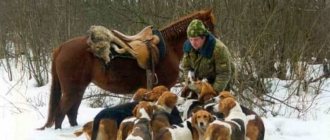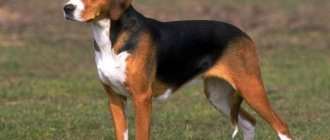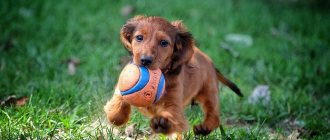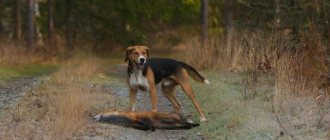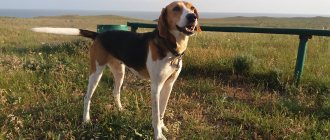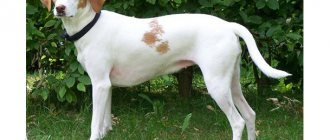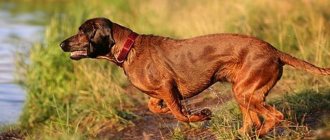The Istrian Hound is a Croatian hunting dog breed that is used primarily for hunting hare and fox. He has a sonorous voice of medium or rough tone, a balanced and flexible character, and is quite easy to train. There are two varieties of Itsrian hounds: smooth-haired and wire-haired, each recognized as an independent breed with its own standard. In fact, their main difference is in the quality and length of the wool.
Origin story
The Istrian Hound (Croatian: Istarski Gonič) is considered the oldest Croatian breed. Her ancestors were among the first to appear on the Balkan Peninsula. According to some sources, organized breeding of these dogs has been going on since the 14th century. However, some dog experts are of the opinion that the breed began to form much later. Paintings from the 18th century already depict dogs that look very much like modern representatives of the breed.
The history of the smooth and rough-haired Istrian hounds is inextricably linked. Written mentions and objects of art with the second variety are much less common. Wire-haired dogs were described at the beginning of the 20th century. Then they were very popular in the Croatian cities of Pazin and Buzet, where they were called Barbini. After the First World War they practically disappeared.
Veterinary research indicates a relationship between Istrian hounds and Dalmatians
In the 20s of the 20th century, Standards were developed for the smooth and wire-haired varieties. Dogs began to be registered in the Croatian Stud Book. After the 50's both breeds were recognized by the FCI.
After the collapse of Yugoslavia, Croatia and Slovenia fought for the right to be called the homeland of the Istrian hounds. In 1999, at a meeting of the FCI, the breed was recognized as Croatian.
Appearance
The Istrian Hound is a strong, strong, medium-sized dog with well-developed bones and muscles, snow-white in color with lemon-orange spots. The length of the body exceeds the height by approximately 10%. Sexual dimorphism is pronounced.
- Height at withers - 46-58 cm;
- Weight - 16-24 kg.
Each variety of Istrian hound has its own Standard (No. 151 and No. 152), but the descriptions and requirements in them are almost identical. The exception is the item on coat.
The head is harmonious, 20-24 cm long, without folds or wrinkles. The muzzle is long, wide at the base, tapering towards the nose. The bridge of the nose is straight. The lobe is black or dark brown. The teeth are strong, scissor bite. The eyes are oval in shape, the eyelids are dark. The ears are thin, set slightly above eye level, tapering to the tips, elongated reaching the fangs. The neck is slightly curved, approximately 15-20 cm long.
The case is of a moderately stretched format. The topline falls towards the croup. The back is straight. The loin is short and wide. The croup is long. The chest is deep and wide. The chest circumference is 12-15 cm greater than the height. The abdomen is slightly tucked. The tail is saber-shaped, set high. Limbs with well-developed muscles and bones, strong. The paws are cat-like, with elastic pads and strong claws.
The skin is elastic, pink. Wool:
- Smooth-haired dogs have a dense, fine, glossy coat. Sometimes a little longer on the back of the thighs and underside of the tail, but this is not desirable.
- In wire-haired dogs, they are 5-10 cm long, bristly, matte. Does not fit tightly to the body, sticks out. The undercoat is short and dense. The length and thickness of the outer hair varies in different parts of the body.
The color is snow-white with orange spots, which are usually located on the ears, under the tail and on the body. Speckling on the body is allowed.
Description
The Estonian Hound is very similar to the Beagle (it is slightly larger), so most people will not be able to tell the difference between the two dogs. At the withers, males reach 43-53 cm, females 40-50 cm. Weight depends on age, gender and health, but usually ranges from 15-20 kg. They are longer than they are tall, although this dependence is not as pronounced as in other hounds. This is a working dog and looks muscular and fit, but not squat. The Estonian Hound's tail is quite long, saber-shaped, and carried low.
The head is proportional to the body, but rather elongated. The skull is wide, dome-shaped, the transition to the muzzle is pronounced, but the stop is smooth. The muzzle itself is long, almost as long as the skull. Lips tightly compressed. The nose is large and black, although brown is acceptable for dogs with yellow spots. The ears are thin, long, set low and rounded at the tips. They hang along the cheeks, but not too close. The eyes of the Estonian Hound are dark brown, almond-shaped, small to medium in size. The overall impression of the dog is sweet, friendly and charming.
The coat is short, rough, but shiny. A soft, wavy or very short coat is a disqualifier. Dogs have an undercoat, but it is poorly defined. The length of the coat is the same throughout the body, with the exception of the ears, muzzle, tip of the tail and the front of the paws. Since the tail is the same length as the rest of the body, the tail looks thicker than it actually is.
The coat color is tricolor: black and piebald, brown and piebald, crimson piebald and saddleback. All dogs have a white tail tip.
Character and behavior
Istrian hounds are active, lively and loyal dogs, intelligent, curious and quite independent, but at the same time easy to train. This allows owners to engage in various sports with them outside the hunting season (coursing, agility, trekking). Gets along well with other pets if raised appropriately.
Balanced character. Restrained attitude towards strangers. No signs of aggression or timidity. Has a guard instinct. In everyday life, she is playful, friendly, affectionate with all family members, sociable and open. The dog is quiet in the house and in the yard. At the same time, the Istrian hound is a passionate hunter with good instincts and expressed anger towards the animal. Drives game with a strong, ringing voice.
The Istrian hound is used for hunting hare, fox, wild boar and poultry.
Review of hunting dog breeds - Hounds.
Hounds (there are more than 80 breeds) raise the animal and chase it with loud barking, overtake and attack it, or drive the animal towards the hunter.
Well-developed orientation allows dogs to chase an animal in dense thickets and return back unerringly. A good sense of smell allows you to select the scent of the hunted animal from other traces. They work great on the blood trail.
They are divided into groups of high-legged hounds and low-legged (short-legged) hounds.
The most popular: Russian hound and Russian piebald hound, beagle and basset hound—English hounds, dachshund breed.
The Russian hound is a hardy and courageous dog with excellent hunting qualities. Very ferocious towards animals, but friendly towards humans. Used exclusively for hunting. Can take on a wolf alone.
The Russian Piebald Hound is a strong, muscular dog. The color is black and tan, the belly and limbs are white. The dog is obedient and friendly to humans, but is not designed to be kept in a city apartment.
Beagles are a breed of small hounds. A small, neatly built dog. The color is the most varied. A dog with a soft, obedient character. Used for baiting hares and foxes. Gets along great in an apartment.
The Basset Hound (or Hound) is a low-legged hound, a hardy, powerful aristocrat dog. Previously used for game and small animals. Currently, it is more of a decorative dog than a hunting dog.
Dachshund Bracket - Westphalian Hound Dachshund and Alpine Hound Dachshund. Breeds of short-legged dogs. They are successfully used for hunting in mountainous conditions and in limited areas. They are used for hunting hare, fox, wild boar and searching for and apporting game. Quite wayward and cunning dogs. Children are treated calmly.
Other breeds of hounds:
Alpine daxbrakke (Alpine dachshund breed). Hunting in the mountains for deer, foxes, and rabbits. Bill n'blue (American blue Gascony hound). For fox, puma in the mountains and other game. American Foxhound. Fox hunter. Anglo-French hound. Ariège Hound. Hunting in a pack. Austrian Hound (Brandle Brak). When hunting, he works without a voice. Balkan hound. Stubborn when given the wrong content. Basset (artesian-Normandy, blue Gascon, fawn Breton-griffon, small Vendean basset-griffon, etc.). Short-legged dogs. Homeland France. Bavarian mountain hound. Hunting for wounded deer and other game. Bernese Hound (Berner Laufhund). Hunting for deer and game. Billy (French). Hunting in a pack for deer. American Coonhound (Black and Tan Coonhound). Raccoon and Possum work. Slovakian cops. Boar hunting. Yellow with a black mask southern hound (USA). (outwardly similar to Labrador). Boar, deer, bear, raccoon. Bloodhound. Large hound (50 kg.). Wolf, lynx, deer. (Movie star). Coonhound (speckled blue coonhound). Raccoon, puma and fox hunter. Bosnian rough-haired hound. Hunting for wild boar, foxes and hare.
Swiss Jurassic Hound (Bruno de Jura). Designed for hunting on foot. Artois hound. Hunting for hare and other small game in a group. French hound. Specializes in deer. German hound (Sauerland breed). For hunting in forests, can serve game. Swedish dachshund hound (drever). Norwegian Hound (Dunker). Hare hunting. English coonhound (red-speckled coonhound). On fox, opossum, cougar, raccoon. English Foxhound. Fox hunting - fox hunting. Estonian hound. Beagle, Foxhound and Swiss hound mix. Finnish hound (suomenajokoira). Large Anglo-French hound. Hunting in a pack and for game. Large blue Gascony hound. Working in cold snow. Large Gascony-Sentauge Hound. Game work. Great Vendean griffin. Hunter of boars, wolves, rabbits. Greek Hare Hound. Hare hunter. Niverneuil griffin. Hunting for wild boar, bear and other game.
Halden Hound (Haldenstevare). Trail work in Norway. Hamilton's hound (Hamiltonstevare). Works alone on the scent. Hanoverian Hound. Working on the trail, unmistakable instincts. Harrier. English breed. Hare hunting. Hugenhund. Norwegian breed. An excellent hunter. Istrian hound..(short-haired and coarse-haired) From Yugoslavia. Blood trail hunter. Kerry Beagle. From Ireland. Hunting for deer and hare. Leopard hound. (North Carolina) Levesque. A very rare breed in France. Lithuanian hound. Hunting for wild boar, hare, fox. Lucerne Hound (Lucerner Laufhund and Lucerner Niederlaufhund).Differ. game. Large tree hound. Hunting on a cold trail for cats. Mountain hound. Driver of animals into trees. Otterhound (otter hound). Works on any game on the trail. Small Vendean Basset Griffon. Raft Hound. American bear breed. Poitevin hound (Poitevin).Wolf hunting. Polish hound (Polish ogar). Hunter of various game on the scent. Porselen (porcelain hound). Hare and deer hunter. Posava Hound. From Slovenia. Deer and hare hunter. Rastreador brasileiro (Brazilian hunt hound). Jaguar hunter. Red Coonhound. Hunter of raccoons and wild cats. Large Spanish hound (Sabuesso Español de Monte). Hunting for animals and serving in the police. Schiller Hound (Schillerstevare). Hunting for hare and fox in the snow.
Swiss Laufhund. Niederlaufhund (low-legged Swiss hound). They differ in size. For hunting in Switzerland. Italian Hound (Segugio Italiano-). Two types: coarse-haired - Segugio Italiano a pelo forte and short-haired - Segugio Italiano a pelo race. Smålandstävare (Småland hound). Swedish city for hare, fox, etc. Stephen's hound. USA. Small mountain hunting dog. Danish dachshund hound (Strellufstever). Deer, fox and hare hunter. Steyer rough-haired highland hound. Austria. Erdeli kopo (Transylvanian hound). Game hunter and carrier. Woody Tennessee Tiger (Tennessee).American South. For raccoon, squirrel, possum. Walker Coonhound (Walker's Tree Coonhound). Many different ones. Work on the trail. Tyrolean hound. Austria. Three varieties based on coat type. Yugoslavian tricolor hound. A rare breed even in its native Yugoslavia. Fox, hare.
Our group: VKontakte Our: Instagram Our website (dedicated to everything everyday) Also our: youtube channel.
Source:Go
Share
010
Content Features
The Istrian Hound is suitable for keeping in a spacious enclosure or in the courtyard of a private house, but in severe frosts it can freeze. Not the best choice for an apartment. In Croatia, dogs are often kept on a leash near a kennel in the yard. Hounds easily jump over small fences and are good at digging holes.
Istra hounds are not too picky about food; they will eat the type of food that the owner offers. This can be natural food or ready-made dry food. Physical activity is very good. It is necessary to maintain the tone and normal psychological state of the dog.
